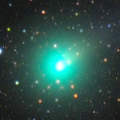
|
Getting brighter much faster than expected. Now it is so bright as 5.5 mag (Feb. 13, Chris Wyatt). It will approach to the sun down to 0.73 A.U. on Mar. 24, and will brighten up to 3 mag. It is observable in good condition in the Southern Hemisphere. It is not observable now in the Northern Hemisphere. But it becomes observable again in May, and it keeps observable in good condition after that while fading gradually.
Date(TT) R.A. (2000) Decl. Delta r Elong. m1 Best Time(A, h)
Feb. 16 23 44.47 -70 51.6 1.028 1.019 60 4.7 19:08 ( 22,-28)
Feb. 23 23 58.95 -59 48.8 1.094 0.933 52 4.2 19:14 ( 34,-26)
|
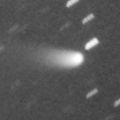
|
Now it is 5.1 mag (Feb. 14, Alexandre Amorim). Although it had been brightening as expected until late December, the brightening has got slow down in January. It was expected to be a great comet of -1 mag in spring, however, it may brightens only up to 3 mag at best. In the Southern Hemisphere, it keeps observable in the low sky until mid February. In the Northern Hemisphere, it keeps unobservable for a long time until March.
Date(TT) R.A. (2000) Decl. Delta r Elong. m1 Best Time(A, h)
Feb. 16 21 20.74 -43 9.9 1.296 0.692 31 5.1 5:20 (306,-26)
Feb. 23 22 29.60 -36 59.3 1.173 0.537 27 4.2 19:14 ( 64,-30)
|
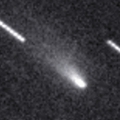
|
Got brighter than expected after the outburst on Jan. 24. It brightened up to 9.2 mag on Feb. 4 (Michael Mattiazzo). However, it suddenly faded down to 10.5 mag and got diffuse on Feb. 5 (Michael Mattiazzo). It approaches to the Sun down to 0.3 A.U. on Feb. 24. The ephemeris says it will brighten up to 7 mag. However, because the comet is small, it may be disintegrated. It is not observable in the Northern Hemisphere. It will be unobservable soon also in the Southern Hemisphere.
Date(TT) R.A. (2000) Decl. Delta r Elong. m1 Best Time(A, h)
Feb. 16 22 48.46 -33 15.3 0.950 0.402 23 8.4 19:08 ( 63,-20)
Feb. 23 22 0.46 -28 7.9 0.916 0.324 19 7.4 5:13 (289,-23)
|
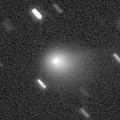
|
It brightened up to 9.0 mag in 2012 autumn (Nov. 4, Juan Jose Gonzalez). Appearing in the morning sky in the Southern Hemisphere. It keeps observable in good condition while fading slowly after this. However, Michael Mattiazzo reported that it was fainter than 12 mag on Feb. 2, much fainter than predicted. In the Northern Hemisphere, it is hardly observable after 2013.
Date(TT) R.A. (2000) Decl. Delta r Elong. m1 Best Time(A, h)
Feb. 16 20 33.88 -38 56.6 2.643 1.885 32 9.1 5:20 (307,-16)
Feb. 23 20 57.73 -40 2.9 2.623 1.911 35 9.2 5:13 (307,-17)
|
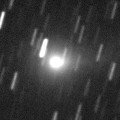
|
Long-lost comet for almost 200 years since 1827. Finally re-discovered by Rob Matson from SWAN images of mid November. Now it is very bright as 9.7 mag (Feb. 8, Gabor Santa). In the Northern Hemisphere, it keeps observable in excellent condition while fading after this. In the Southern Hemisphere, it is only observable in low sky from February to March.
Date(TT) R.A. (2000) Decl. Delta r Elong. m1 Best Time(A, h)
Feb. 16 18 15.12 14 34.2 1.467 1.320 61 10.3 5:20 (283, 42)
Feb. 23 18 4.34 19 55.1 1.385 1.411 70 10.7 5:13 (283, 52)
|
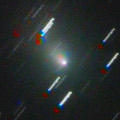
|
Now it is so bright as 11.5 mag (Feb. 6, Salvador Aguirre). It keeps bright as 12 mag until spring. In the Northern Hemisphere, it keeps observable in good condition until April. It is not observable now in the Southern Hemisphere. It will become observable after April, but it keeps locating low.
Date(TT) R.A. (2000) Decl. Delta r Elong. m1 Best Time(A, h)
Feb. 16 2 13.01 42 20.4 1.785 1.884 79 12.5 19:08 (115, 58)
Feb. 23 2 30.63 38 40.6 1.818 1.830 74 12.4 19:14 (109, 55)
|
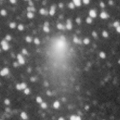
|
Now it is bright as 11.8 mag (Feb. 7, Alexandre Amorim). It is expected to be observable at 11-13 mag for a long time from 2012 summer to 2013 summer.
Date(TT) R.A. (2000) Decl. Delta r Elong. m1 Best Time(A, h)
Feb. 16 16 12.39 -23 21.7 2.448 2.507 81 12.4 5:20 (342, 29)
Feb. 23 16 9.14 -21 10.5 2.351 2.552 90 12.4 5:13 (347, 33)
|

|
It brightened up to 11-12 mag in 2012. Now it is 13.3 mag (Feb. 2, Jakub Cerny). It will be observable at 12-13 mag in good condition again in 2013.
Date(TT) R.A. (2000) Decl. Delta r Elong. m1 Best Time(A, h)
Feb. 16 15 26.73 -17 24.3 5.477 5.626 93 13.0 5:20 (353, 37)
Feb. 23 15 22.98 -17 19.4 5.366 5.647 101 13.0 5:12 ( 0, 38)
|
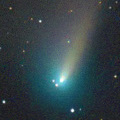
|
It approached to the earth down to 0.3 A.U. and brightened up to 7-8 mag from late December to early January. However, it will go away from the earth and fade out rapidly after this. It has already faded down to 12.2 mag (Feb. 10, Uwe Pilz). It is observable in good condition also in the Southern Hemisphere after this.
Date(TT) R.A. (2000) Decl. Delta r Elong. m1 Best Time(A, h)
Feb. 16 4 5.52 -14 44.8 1.377 1.675 88 13.1 19:08 ( 15, 39)
Feb. 23 4 8.52 -15 40.5 1.561 1.750 83 13.6 19:14 ( 24, 36)
|

|
It brightened rapidly, and reached up to 12 mag in 2012. Appearing in the mornig sky again. It will be observable at 12-14 mag in good condition again in 2013. However, it locates somewhat low in the Northern Hemisphere in 2013. By the way, Juan Jose Gonzalez reported it is extremely bright as 9.6 mag on Jan. 20.
Date(TT) R.A. (2000) Decl. Delta r Elong. m1 Best Time(A, h)
Feb. 16 18 21.34 -23 26.0 3.376 2.881 52 13.6 5:20 (314, 15)
Feb. 23 18 32.29 -23 42.2 3.300 2.883 56 13.6 5:13 (316, 16)
|
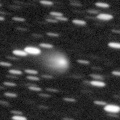
|
Now it is 13.3 mag (Nov. 15, Sandor Szabo). It keeps bright at 13-14 mag for a long time until 2014. It keeps observable for a long time in the Northern Hemisphere. It is not observable in the Southern Hemisphere.
Date(TT) R.A. (2000) Decl. Delta r Elong. m1 Best Time(A, h)
Feb. 16 21 6.52 29 33.9 6.611 5.937 43 13.7 5:20 (245, 16)
Feb. 23 21 9.18 29 30.8 6.611 5.931 43 13.7 5:13 (247, 19)
|
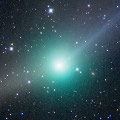
|
It kept as bright as 6-7 mag for a long time from 2011 summer to 2012 spring. Now it is fading. But it is bright as 15.2 mag still now (Feb. 2, Jakub Cerny).
Date(TT) R.A. (2000) Decl. Delta r Elong. m1 Best Time(A, h)
Feb. 16 8 44.46 -10 44.3 4.191 5.075 150 13.7 22:57 ( 0, 44)
Feb. 23 8 37.39 -10 29.3 4.285 5.138 146 13.8 22:23 ( 0, 44)
|
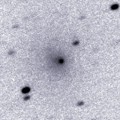
|
Carlos Labordena reported it is extremely bright as 11.4 mag on Feb. 6. However, it is extremely diffuse.
Date(TT) R.A. (2000) Decl. Delta r Elong. m1 Best Time(A, h)
Feb. 16 14 12.17 -23 39.6 5.851 6.230 108 13.8 4:29 ( 0, 31)
Feb. 23 14 11.99 -23 51.2 5.745 6.229 115 13.8 4:01 ( 0, 31)
|
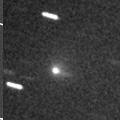
|
Now it is 13.6 mag (Feb. 17, Todd Augustyniak). It is fainter than originally predicted by 1 mag. It will brighten up to 14 mag until spring. In the Northern Hemisphere, it keeps observable in excellent condition. In the Southern Hemisphere, it keeps locating extremely low for a while.
Date(TT) R.A. (2000) Decl. Delta r Elong. m1 Best Time(A, h)
Feb. 16 10 7.48 34 46.9 1.073 2.022 157 14.3 0:25 ( 0, 90)
Feb. 23 9 59.99 33 35.8 1.061 2.005 155 14.2 23:45 ( 0, 88)
|
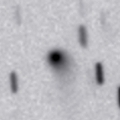
|
It is expected to keep 13 mag and observable in good condition in the Northern Hemisphere for a long time from 2013 to 2014. Now it is 14.5 mag (Feb. 9, Yasukazu Ikari). It will be observable also in the Southern Hemisphere from early December to early March, although it locates low.
Date(TT) R.A. (2000) Decl. Delta r Elong. m1 Best Time(A, h)
Feb. 16 10 51.34 39 55.7 3.570 4.454 150 14.3 1:09 (180, 85)
Feb. 23 10 40.82 41 54.6 3.546 4.415 147 14.2 0:31 (180, 83)
|

|
Big asteroid discovered in 1906. It suddenly showed the cometary activity on Dec. 11, 2010, probably due to an impact of a small object. Now it is 11.9 mag (May 29, Marco Goiato). It has already turned to be stellar. It is not observable now.
Date(TT) R.A. (2000) Decl. Delta r Elong. m1 Best Time(A, h)
Feb. 16 21 41.22 -24 19.4 3.658 2.702 12 14.3 5:20 (286,-21)
Feb. 23 21 53.99 -23 27.1 3.654 2.713 15 14.3 5:13 (286,-19)
|
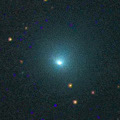
|
First return of a new periodic comet discovered in 1994. It brightened rapidly and reached up to 10.6 mag (Dec. 13, Katsumi Yoshimoto). Now it is fading, but it is bright as 11.5 mag still now (Feb. 10, Uwe Pilz). It has a large diffuse coma. It keeps locating high for a while, but it will be fading after this.
Date(TT) R.A. (2000) Decl. Delta r Elong. m1 Best Time(A, h)
Feb. 16 3 9.49 -5 59.3 1.519 1.613 76 14.5 19:08 ( 36, 42)
Feb. 23 3 29.44 -5 16.7 1.615 1.669 75 14.9 19:14 ( 40, 41)
|
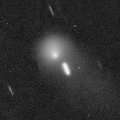
|
Now it is 14.7 mag (Feb. 3, Jakub Cerny). It will be fading slowly after this. But it keeps 15 mag in 2013. It is observable in good condition in the Southern Hemisphere. It becomes observable in the extremely low sky from January to February in the Northern Hemisphere.
Date(TT) R.A. (2000) Decl. Delta r Elong. m1 Best Time(A, h)
Feb. 16 2 56.77 -40 8.5 6.488 6.226 70 14.5 19:08 ( 22, 10)
Feb. 23 2 58.27 -38 40.9 6.571 6.250 66 14.5 19:14 ( 29, 9)
|

|
Now it is bright and visible visually at 12.9 mag (Jan. 3, Chris Wyatt). It keeps 12-14 mag until February. It keeps observable in good condition in the Northern Hemisphere. In the Southern Hemisphere, it locates extremely low, and will be unobservable soon.
Date(TT) R.A. (2000) Decl. Delta r Elong. m1 Best Time(A, h)
Feb. 16 1 28.23 17 31.1 3.612 3.232 59 14.6 19:08 ( 83, 42)
Feb. 23 1 38.62 17 27.8 3.710 3.247 55 14.7 19:14 ( 86, 37)
|
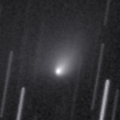
|
Now it is visible visually at 13.7 mag (Dec. 23, Juan Jose Gonzalez). It keeps 15 mag until March. In the Northern Hemisphere, it keeps observable for a long time until the comet fades out. It is not observable in the Southern Hemisphere, except for 2013 spring, but the comet locates extremely low only.
Date(TT) R.A. (2000) Decl. Delta r Elong. m1 Best Time(A, h)
Feb. 16 3 49.34 42 29.4 2.008 2.340 96 15.2 19:08 (125, 76)
Feb. 23 3 56.73 38 36.2 2.132 2.362 90 15.4 19:14 (107, 72)
|
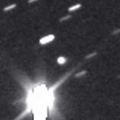
|
Now it is 15.0 mag (Feb. 2, Uwe Pilz). Already visible visually. It is expected to be a great comet in 2013 autumn when the comet approaches to the sun down to only 0.01 A.U. It keeps visible with naked eyes from November to January, and can be extremely bright as Venus or more at the highlight. The condition is excellent in the Northern Hemisphere. It keeps observable almost all through the period of brightening, at the highlight, and of fading. The condition is not good in the Southern Hemisphere. It is not observable at all the latter part of the highlight, and it keeps low all through the period.
Date(TT) R.A. (2000) Decl. Delta r Elong. m1 Best Time(A, h)
Feb. 16 7 1.95 31 45.2 4.009 4.762 135 15.3 21:15 ( 0, 87)
Feb. 23 6 55.68 31 39.9 4.020 4.684 127 15.2 20:42 ( 0, 87)
|
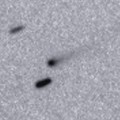
|
Now it is 16.3 mag (Feb. 10, Hiroshi Abe). It keeps bright as 13-14 mag for a long time from 2013 to 2014.
Date(TT) R.A. (2000) Decl. Delta r Elong. m1 Best Time(A, h)
Feb. 16 14 48.31 -10 51.8 3.214 3.588 104 15.5 5:05 ( 0, 44)
Feb. 23 14 50.53 -11 1.5 3.101 3.573 110 15.4 4:39 ( 0, 44)
|
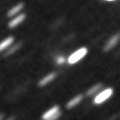
|
Now it is 15.6 mag (Jan. 23, W. Hasubick). It will brighten up to 12 mag from summer to autumn in 2013. In the Northern Hemisphere, it is observable only until spring when the comet brightens up to 15 mag. In the Southern Hemisphere, it keeps unobservable until August. Then it keeps observable while fading gradually.
Date(TT) R.A. (2000) Decl. Delta r Elong. m1 Best Time(A, h)
Feb. 16 0 27.97 49 48.1 2.970 2.798 70 15.8 19:08 (129, 41)
Feb. 23 0 44.95 48 39.1 2.972 2.727 66 15.7 19:14 (128, 38)
|
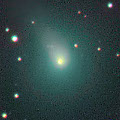
|
It brightened much faster than expected, and reached up to 10.0 mag in summer (Aug. 9, Juan Jose Gonzalez). Now it is fading, but it is bright as 13.3 ma still now (Feb. 2, Hidetaka Sato). It keeps observable in good condition for a while after this.
Date(TT) R.A. (2000) Decl. Delta r Elong. m1 Best Time(A, h)
Feb. 16 6 54.49 7 3.0 2.411 3.183 134 15.7 21:07 ( 0, 62)
Feb. 23 6 46.71 6 6.0 2.557 3.238 125 16.0 20:32 ( 0, 61)
|

|
Now it is 15.8 mag, brighter than expected (Feb. 4, Hidetaka Sato). It reaches up to 15 mag from spring to summer. It is observable in excellent condition in the Southern Hemisphere. It locates low in the Northern Hemisphere.
Date(TT) R.A. (2000) Decl. Delta r Elong. m1 Best Time(A, h)
Feb. 16 16 49.70 -49 25.9 3.640 3.468 72 15.9 5:20 (343, 2)
Feb. 23 16 45.97 -49 29.5 3.500 3.452 79 15.8 5:13 (347, 4)
|
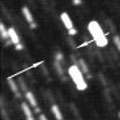
|
Now it is 16.1 mag (Jan. 16, Jakub Cerny). In the Southern Hemisphere, it will be observable at 15-16 mag in good condition for a long time until summer. It is not observable at all in the Northern Hemisphere.
Date(TT) R.A. (2000) Decl. Delta r Elong. m1 Best Time(A, h)
Feb. 16 1 24.50 -64 50.9 4.549 4.195 63 16.0 19:08 ( 21,-18)
Feb. 23 1 40.35 -63 5.7 4.566 4.218 63 16.0 19:14 ( 24,-18)
|
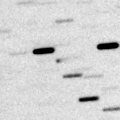
|
Now it is 17.5 mag (Jan. 17, Hidetaka Sato). It keeps observable at 16 mag in the morning sky from February to April.
Date(TT) R.A. (2000) Decl. Delta r Elong. m1 Best Time(A, h)
Feb. 16 18 9.48 -15 13.3 1.852 1.525 55 16.2 5:20 (311, 23)
Feb. 23 18 31.37 -14 51.7 1.818 1.527 57 16.0 5:13 (310, 23)
|
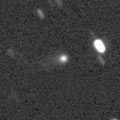
|
Now it is 14.8 mag (Jan. 9, A. Novichonok). It keeps 15-16 mag until February. It keeps observable in good condition for a long time until the comet fades out in the Northern Hemisphere. It is not observable until 2013 summer in the Southern Hemisphere. By the way, Juan Jose Gonzalez reported it extremely bright as 10.4 mag visually on Nov. 6.
Date(TT) R.A. (2000) Decl. Delta r Elong. m1 Best Time(A, h)
Feb. 16 0 46.73 49 59.0 3.833 3.659 72 16.2 19:08 (129, 44)
Feb. 23 0 53.11 48 18.2 3.952 3.676 66 16.3 19:14 (127, 39)
|
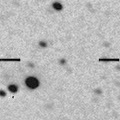
|
Now it is 16.4 mag (Jan. 6, J. F. Hernandez). It is expected to brighten up to 5-6 mag in 2014 autumn. In 2013, it keeps observable in good condition until autumn when it brigthens up to 13-14 mag.
Date(TT) R.A. (2000) Decl. Delta r Elong. m1 Best Time(A, h)
Feb. 16 17 31.56 10 13.7 6.837 6.563 69 16.3 5:20 (297, 48)
Feb. 23 17 32.68 10 48.5 6.679 6.502 75 16.3 5:13 (302, 52)
|

|
New bright comet discovered at 15 mag in late December. Now it is 15.8 mag (Feb. 4, Hidetaka Sato). It must have been bright as 13-14 mag and observable in good condition from spring to autumn in the Southern Hemisphere. But it was not discovered. It will be fainter than 18 mag in April, and keeps observable in good condition. It will be observable also in the Northern Hemisphere after this in the evening sky while fading gradually.
Date(TT) R.A. (2000) Decl. Delta r Elong. m1 Best Time(A, h)
Feb. 16 5 14.65 -33 44.2 2.401 2.728 98 16.3 19:28 ( 0, 22)
Feb. 23 5 17.70 -30 2.5 2.500 2.787 96 16.4 19:14 ( 2, 25)
|
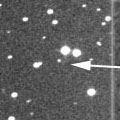
|
Now it is 16.4 mag (Jan. 18, Yasukazu Ikari). It will be observable at 17 mag for a long time from 2013 to 2014.
Date(TT) R.A. (2000) Decl. Delta r Elong. m1 Best Time(A, h)
Feb. 16 12 21.07 4 47.4 3.084 3.925 143 16.7 2:38 ( 0, 60)
Feb. 23 12 18.89 5 0.9 3.020 3.917 151 16.6 2:08 ( 0, 60)
|
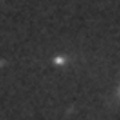
|
Now it is 17.4 mag (Jan. 5, K. Hills). It keeps observable in good condition at 17 mag from January to June. It locates somewhat low in the Southern Hemisphere.
Date(TT) R.A. (2000) Decl. Delta r Elong. m1 Best Time(A, h)
Feb. 16 9 4.61 19 59.0 1.123 2.094 165 17.0 23:18 ( 0, 75)
Feb. 23 9 0.19 20 45.8 1.127 2.074 156 16.9 22:46 ( 0, 76)
|
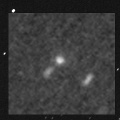
|
It is expected to brighten up to 11 mag and become observable in excellent condition in 2014 spring. Now it is 17.9 mag (Jan. 3, Toshiyuki Takahashi). In the Northern Hemisphere, it keeps observable in good condition until early summer. It locates low in the Southern Hemisphere.
Date(TT) R.A. (2000) Decl. Delta r Elong. m1 Best Time(A, h)
Feb. 16 9 0.59 38 42.3 3.692 4.579 150 17.4 23:14 (180, 86)
Feb. 23 8 54.74 39 22.1 3.675 4.516 144 17.4 22:40 (180, 86)
|
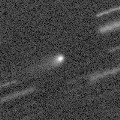
|
Now it is 17.8 mag (Jan. 11, P. Dupouy, et al.). It brightened up to 16.5 mag in 2012. It will be observable in good condition again at 17.5 mag in 2013 spring.
Date(TT) R.A. (2000) Decl. Delta r Elong. m1 Best Time(A, h)
Feb. 16 14 5.59 3 37.9 5.427 5.958 118 17.4 4:22 ( 0, 59)
Feb. 23 14 0.41 4 12.4 5.336 5.975 126 17.4 3:49 ( 0, 59)
|
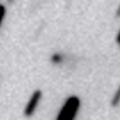
|
It was identified with an old comet discovered in 1931 by Tombaugh. It was unusually bright as 12.5 mag in 1931. Now it is 16.9 mag (Jan. 19, Y. Sugiyama). It keeps 17.5 mag until March, and keeps observable in excellent condition in the Northern Hemisphere. It locates low in the Southern Hemisphere.
Date(TT) R.A. (2000) Decl. Delta r Elong. m1 Best Time(A, h)
Feb. 16 6 41.47 36 36.6 1.688 2.442 129 17.5 20:55 (180, 88)
Feb. 23 6 42.89 36 45.0 1.754 2.442 123 17.6 20:29 (180, 88)
|
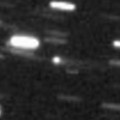
|
Now it is 17.7 mag (Jan. 11, V. Gerke, S. Plaksa, A. Novichonok). It reached up to 17 mag in last winter between 2011 and 2012. It will be observable in good condition again at 17.5 mag in this winter.
Date(TT) R.A. (2000) Decl. Delta r Elong. m1 Best Time(A, h)
Feb. 16 9 17.67 17 31.8 3.214 4.188 169 17.7 23:31 ( 0, 72)
Feb. 23 9 13.68 17 46.6 3.249 4.197 161 17.8 22:59 ( 0, 73)
|

|
Not observed yet in this apparition. But it must have already brightened up to 18 mag. It will brighten up to 14 mag and will be observable in excellent condition in summer.
Date(TT) R.A. (2000) Decl. Delta r Elong. m1 Best Time(A, h)
Feb. 16 14 48.39 -2 21.9 1.830 2.312 106 18.1 5:04 ( 0, 53)
Feb. 23 14 55.99 -2 12.4 1.715 2.272 111 17.8 4:45 ( 0, 53)
|
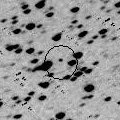
|
Peculiar asteroid moving along a cometary orbit. Now it is 17.3 mag (Dec. 6, E. Cozzi). It keeps observable at 18 mag for a long time from 2008 to 2014. It locates extremely low in the Southern Hemisphere.
Date(TT) R.A. (2000) Decl. Delta r Elong. m1 Best Time(A, h)
Feb. 16 6 59.97 42 27.4 6.524 7.213 131 17.8 21:13 (180, 83)
Feb. 23 6 55.62 42 41.5 6.626 7.226 124 17.9 20:42 (180, 82)
|
|
![]()
 C/2011 O1 ( LINEAR )
C/2011 O1 ( LINEAR ) 125P/Spacewatch
125P/Spacewatch C/2012 A2 ( LINEAR )
C/2012 A2 ( LINEAR ) C/2012 K1 ( PanSTARRS )
C/2012 K1 ( PanSTARRS ) C/2012 Y3 ( McNaught )
C/2012 Y3 ( McNaught ) P/2012 B1 ( PanSTARRS )
P/2012 B1 ( PanSTARRS ) 175P/Hergenrother
175P/Hergenrother C/2012 X1 ( LINEAR )
C/2012 X1 ( LINEAR ) C/2010 R1 ( LINEAR )
C/2010 R1 ( LINEAR ) 274P/2012 WX32 ( Tombaugh-Tenagra )
274P/2012 WX32 ( Tombaugh-Tenagra ) 244P/2010 Q1 ( Scotti )
244P/2010 Q1 ( Scotti ) 98P/Takamizawa
98P/Takamizawa (342842) 2008 YB3
(342842) 2008 YB3![]()


































